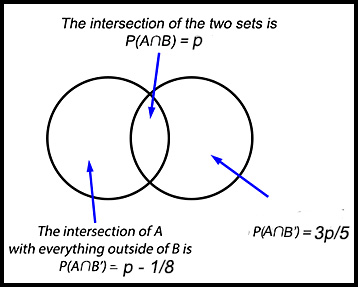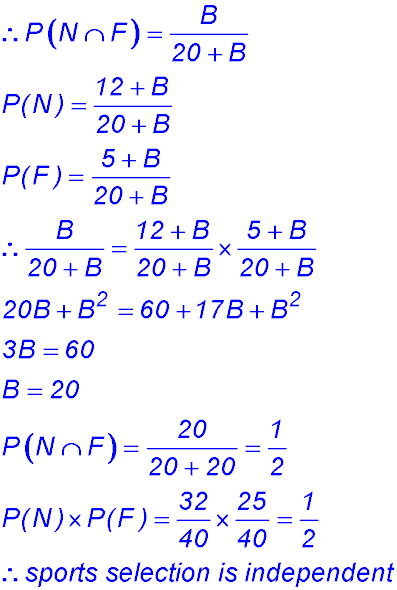Where the techniques of Maths
are explained in simple terms.
Probability - Independence of sets.
Test Yourself 1 - Solutions.
- Algebra & Number
- Calculus
- Financial Maths
- Functions & Quadratics
- Geometry
- Measurement
- Networks & Graphs
- Probability & Statistics
- Trigonometry
- Maths & beyond
- Index
Remember that if two sets A and B are independent, then P(A∩B) = P(A) P(B).
This relationship is referred to as the MULTIPLICATION LAW.
It is the same concept as two events happening sequentially with replacement.
1. The events:
|
|||||||||||||||||
| 2. | |||||||||||||||||
3.
If the two outcomes of headache (H) and dizziness (D) are independent, then P(H∩D) = P(H) P(D).
P(H) × P(D) = 15% which is not 10% - so not independent. |
|||||||||||||||||
| 4. It is given that A and B are independent events so we immediately write:
P(A∩B) = P(A)P(B). As P(A) = 2P(B) then P(A∩B) = 2[P(B)]2. P(A∪B) = 0.52 = P(A) + P(B) - P(A∩B). ∴ 0.52 = 3P(B) - 2[P(B)]2. 2[P(B)]2 - 3P(B) + 0.52 = 0 Using the quadratic formula to solve for P(B) gives: P(B) = 1.3 (not possible) and P(B) = 0.2. ∴ P(A) = 0.4. |
|||||||||||||||||
5. For events A and B, P(A∩B) = p, P(A'∩B) = p - 1/8
If A and B are independent, determine the value of p. |
|||||||||||||||||
7. We know that for independence P(A∩ B) = P(A)×P(B). Well there are 12 + 5 + B + 3 = 20 + B girls. We can therefore divide the frequencies:
|
|||||||||||||||||
| Advanced questions. | A local supermarket was reviewing its operations. It wanted to improve its customer relations and, as part of that review, decided to determine when customers were most likely to visit the store
The researcher developed the following table:
Three percentages from the review are entered into the above table together with the total percentage or respondents. (i) Complete the percentage entries in the table. (ii) By converting the percentages to probabilities, evaluate the conclusion that time of shopping and day of the week are independent events. |
||||||||||||||||

